This article needs additional citations for verification .(June 2018) |
 |
| Speculative fiction |
|---|
| |
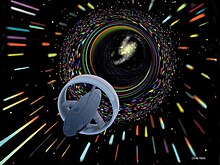
The following is a list of articles about recurring themes in science fiction.
This article needs additional citations for verification .(June 2018) |
 |
| Speculative fiction |
|---|
| |

The following is a list of articles about recurring themes in science fiction.
The Fermi paradox is the discrepancy between the lack of conclusive evidence of advanced extraterrestrial life and the apparently high likelihood of its existence. As a 2015 article put it, "If life is so easy, someone from somewhere must have come calling by now."

The following outline is provided as an overview and topical guide to space science:

Mind uploading is a speculative process of whole brain emulation in which a brain scan is used to completely emulate the mental state of the individual in a digital computer. The computer would then run a simulation of the brain's information processing, such that it would respond in essentially the same way as the original brain and experience having a sentient conscious mind.
A sleeper ship is a hypothetical type of crewed spacecraft, or starship in which most or all of the crew spend the journey in some form of hibernation or suspended animation. The only known technology that allows long-term suspended animation of humans is the freezing of early-stage human embryos through embryo cryopreservation, which is behind the concept of embryo space colonization.
Science fiction is a film genre that uses speculative, fictional science-based depictions of phenomena that are not fully accepted by mainstream science, such as extraterrestrial lifeforms, spacecraft, robots, cyborgs, mutants, interstellar travel, time travel, or other technologies. Science fiction films have often been used to focus on political or social issues, and to explore philosophical issues like the human condition.
Orion's Arm is a multi-authored online science fiction world-building project, first established in 2000 by M. Alan Kazlev, Donna Malcolm Hirsekorn, Bernd Helfert and Anders Sandberg and further co-authored by many people since. Anyone can contribute articles, stories, artwork, or music to the website. A large mailing list exists, in which members debate aspects of the world they are creating, discussing additions, modifications, issues arising, and work to be done.
The concept of self-replicating spacecraft, as envisioned by mathematician John von Neumann, has been described by futurists including physicist Michio Kaku and has been discussed across a wide breadth of hard science fiction novels and stories. Self-replicating probes are sometimes referred to as von Neumann probes. Self-replicating spacecraft would in some ways either mimic or echo the features of living organisms or viruses.
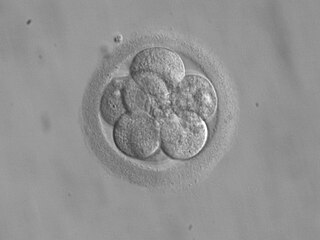
Embryo space colonization is a theoretical interstellar space colonization concept that involves sending a robotic mission to a habitable terrestrial planet, dwarf planet, minor planet or natural satellite transporting frozen early-stage human embryos or the technological or biological means to create human embryos. The proposal circumvents the most severe technological problems of other mainstream interstellar colonization concepts. In contrast to the sleeper ship proposal, it does not require the more technically challenging 'freezing' of fully developed humans.
The use of nanotechnology in fiction has attracted scholarly attention. The first use of the distinguishing concepts of nanotechnology was "There's Plenty of Room at the Bottom", a talk given by physicist Richard Feynman in 1959. K. Eric Drexler's 1986 book Engines of Creation introduced the general public to the concept of nanotechnology. Since then, nanotechnology has been used frequently in a diverse range of fiction, often as a justification for unusual or far-fetched occurrences featured in speculative fiction.

Many of the tropes of science fiction can be viewed as similar to the goals of transhumanism. Science fiction literature contains many positive depictions of technologically enhanced human life, occasionally set in utopian societies. However, science fiction's depictions of technologically enhanced humans or other posthuman beings frequently come with a cautionary twist. The more pessimistic scenarios include many dystopian tales of human bioengineering gone wrong.
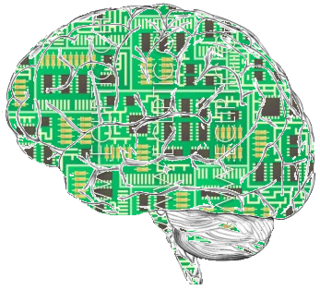
Mind uploading, whole brain emulation, or substrate-independent minds, is a use of a computer or another substrate as an emulated human brain. The term "mind transfer" also refers to a hypothetical transfer of a mind from one biological brain to another. Uploaded minds and societies of minds, often in simulated realities, are recurring themes in science-fiction novels and films since the 1950s.

Saturn has made appearances in fiction since the 1752 novel Micromégas by Voltaire. In the earliest depictions, it was portrayed as having a solid surface rather than its actual gaseous composition. In many of these works, the planet is inhabited by aliens that are usually portrayed as being more advanced than humans. In modern science fiction, the Saturnian atmosphere sometimes hosts floating settlements. The planet is occasionally visited by humans and its rings are sometimes mined for resources.

Mundane science fiction (MSF) is a niche literary movement within science fiction that developed in the early 2000s, with principles codified by the "Mundane Manifesto" in 2004, signed by author Geoff Ryman and "The Clarion West 2004 Class". The movement proposes "mundane science fiction" as its own subgenre of science fiction, typically characterized by its setting on Earth or within the Solar System; a lack of interstellar travel, intergalactic travel or human contact with extraterrestrials; and a believable use of technology and science as it exists at the time the story is written or a plausible extension of existing technology. There is debate over the boundaries of MSF and over which works can be considered canonical. Rudy Rucker has noted MSF's similarities to hard science fiction and Ritch Calvin has pointed out MSF's similarities to cyberpunk. Some commentators have identified science fiction films and television series which embody the MSF ethos of near-future realism.

Artificial intelligence is a recurrent theme in science fiction, whether utopian, emphasising the potential benefits, or dystopian, emphasising the dangers.
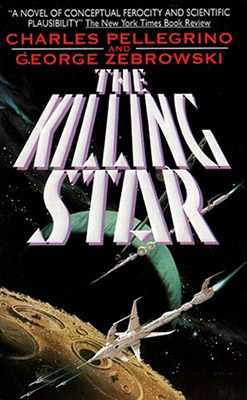
The Killing Star is a hard science fiction novel by American writers Charles R. Pellegrino and George Zebrowski, published in April 1995. It chronicles a sudden alien invasion in a late 21st century technological utopia, while covering several other speculative fiction ideas such as sublight interstellar travel, genetic cloning, virtual reality, advanced robotics, etc.
Digital immortality is the hypothetical concept of storing a person's personality in digital substrate, i.e., a computer, robot or cyberspace. The result might look like an avatar behaving, reacting, and thinking like a person on the basis of that person's digital archive. After the death of the individual, this avatar could remain static or continue to learn and self-improve autonomously.
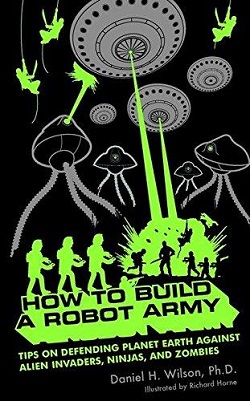
How to Build a Robot Army: Tips on Defending Planet Earth Against Alien Invaders, Ninjas, Monsters, and Zombies is a semi-satirical non-fiction book by Daniel Wilson published in December 2007.
Hypothetical technology is technology that does not exist yet, but that could exist in the future. This article presents examples of technologies that have been hypothesized or proposed, but that have not been developed yet. An example of hypothetical technology is teleportation.

AI takeover—the idea that some kind of artificial intelligence may supplant humankind as the dominant intelligent species on the planet—is a common theme in science fiction. Famous cultural touchstones include Terminator and The Matrix.

Pastoral science fiction is a subgenre of science fiction which uses bucolic, rural settings, like other forms of pastoral literature. Since it is a subgenre of science fiction, authors may set stories either on Earth or another habitable planet or moon, sometimes including a terraformed planet or moon. Unlike most genres of science fiction, pastoral science fiction works downplay the role of futuristic technologies. The pioneer is author Clifford Simak (1904–1988), a science fiction Grand Master whose output included stories written in the 1950s and 1960s about rural people who have contact with extraterrestrial beings who hide their alien identity.
{{cite book}}: |website= ignored (help)